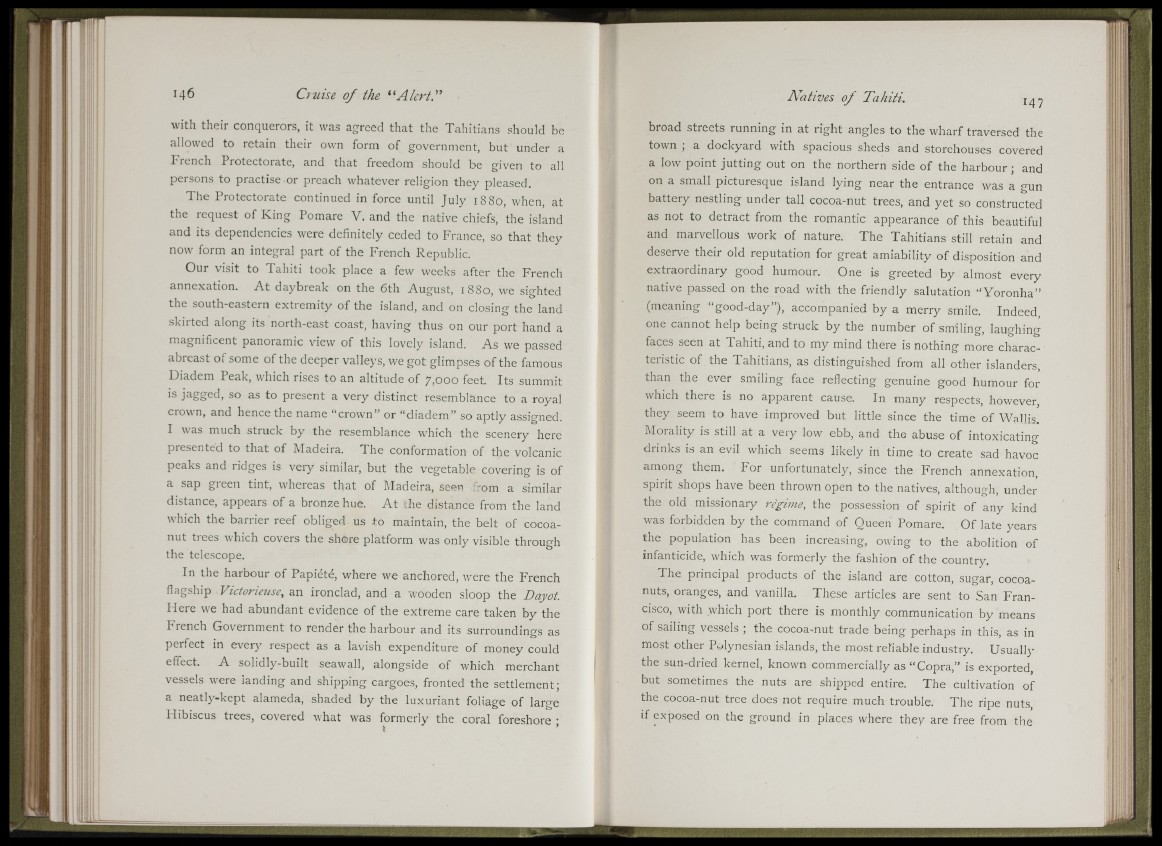
i y
I =1 7
If
i
p'M
• fe M Î
I i
t 1
"■' '.Ml i
I;!
lit
; ;1
' i '
■ ^
ÎÎ- i
@ II
Î *1....
i 1,
'i t » i K i II
it
146 Ciuise o f the “A lert.”
with their conquerors, it was agreed that the Tahitians should be
allowed to retain their own form of government, but under a
French Protectorate, and that freedom should be given to all
persons to practise or preach whatever religion they pleased.
The Protectorate continued in force until July 1880, when, at
the request of King Pomare V. and the native chiefs, the island
and its dependencies were definitely ceded to France, so that they
now form an integral part of the French Republic.
Our visit to Tahiti took place a few weeks after the French
annexation. A t daybreak on the 6th August, 1880, we sighted
the south-eastern extremity of the island, and on closing the land
skirted along its north-east coast, having thus on our port hand a
magnificent panoramic view of this lovely island. As we passed
abreast of some of the deeper valleys, we got glimpses of the famous
Diadem Peak, which rises to an altitude of y,ooo feet. Its summit
is jagged, so as to present a very distinct resemblance to a royal
crown, and hence the namm “ crown” or “ diadem” so aptly assigned.
I was much struck by the resemblance which the scenery here
presented to that of Madeira. The conformation of the volcanic
peaks and ridges is very similar, but the vegetable covering is of
a sap green tint, whereas that of Madeira, seen -om a similar
distance, appears of a bronze hue. A t die distance from the land
which the barrier reef obliged us to maintain, the belt of cocoa-
nut trees which covers the shore platform was only visible through
the telescope.
In the harbour of Papiete, where we anchored, were the PTench
flagship Victorieuse, an ironclad, and a wooden sloop the Dayot.
Here we had abundant evidence of the extreme care taken by the
French Government to render the harbour and its surroundings as
perfect in every respect as a lavish expenditure of money could
effect. A solidly-built seawall, alongside of which merchant
vessels were landing and shipping cargoes, fronted the settlement;
a neatly-kept alameda, shaded by the luxuriant foliage of large
Hibiscus trees, covered what was formerly the coral foreshore ;
A^atives o f Tahiti. 147
broad streets running in at right angles to the wharf traversed the
town ; a dockyard with spacious sheds and storehouses covered
a low point jutting out on the northern side of the harbour ; and
on a small picturesque island lying near the entrance was a gun
battery nestling under tall cocoa-nut trees, and yet so constructed
as not to detract from the romantic appearance of this beautiful
and marvellous work of nature. The Tahitians still retain and
deserve their old reputation for great amiability of disposition and
extraordinary good humour. One is greeted by almost every
native passed on the road with the friendly salutation “ Yoronha”
(meaning “ good-day”), accompanied by a merry smile. Indeed,
one cannot help being struck by the number of smiling, laughing
faces seen at Tahiti, and to my mind there is nothing more characteristic
of the Tahitians, as distinguished from all other islanders,
than the ever smiling face reflecting genuine good humour for
which there is no apparent cause. In many respects, however,
they seem to have improved but little since the time of Wallis.
Morality is still at a very low ebb, and the abuse of intoxicating
drinks is an evil which seems likely in time to create sad havoc
among them. For unfortunately, since the French annexation,
spirit shops have been thrown open to the natives, although, under
the old missionary régime, the possession of spirit of any kind
was forbidden by the command of Queen Pomare. Of late years
the population has been increasing, owing to the abolition of
infanticide, which was formerly the fashion of the country.
The principal products of the island are cotton, sugar, cocoa-
nuts, oranges, and vanilla. These articles are sent to San Francisco,
with which port there is monthly communication by means
of sailing vessels ; the cocoa-nut trade being perhaps in this, as in
most other Polynesian islands, the most reliable industry. Usually
the sun-dried kernel, known commercially as “ Copra,” is exported,
but sometimes the nuts are shipped entire. The cultivation of
the cocoa-nut tree does not require much trouble. The ripe nut.s,
if exposed on the ground in places where they are free from the
I!!
îMïiii
îl;,
III
là'